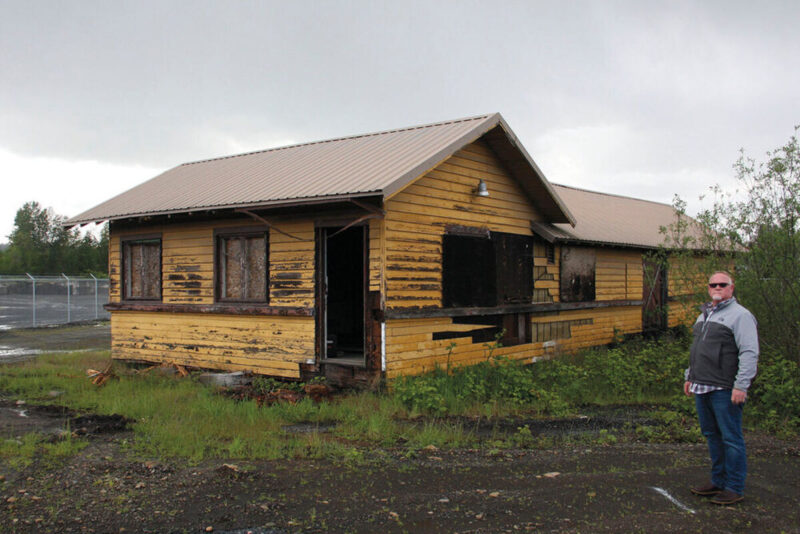Benny Westcott
A piece of local history faces demolition if no one steps up to save it.
The dilapidated Oregon Electric Railroad depot sits at the north end of the Sweet Home Public Works Yard, suffering from severe rot and defaced by graffiti over its 80-year lifespan. It currently occupies an area where an access road is planned for Linn County’s proposed RV fill/dump station and the Family Assistance and Resource Center’s homeless facility.
Since the depot stands in the way, Public Works Director Greg Springman said it needs to be moved in the next 30 to 60 days.
Originally located at the site of the current McDonald’s, in the 2000 block of Main Street, the depot was built in the early 1930s, when two spurs met there and ran southwest toward Holley. Over the next decade, the main line spur came together with another just south, and ran south through Sweet Home, across the Huskies baseball complex, the Jim Riggs Community Center and Sankey Park, then west along the south edge of town along what is now the South Hills Trail toward Holley. Trains turned around using switches at the intersection.
When a McDonald’s was slated for that property in the late 1980s, civic leaders Ben Dahlenburg, Bob Waibel and John Slauson led an effort to move the depot north along an old railroad spur to make room for the new restaurant.
The depot then sat behind the McDonald’s on property owned by Lester Sales until Bi-Mart purchased it for a new store in the spring of 2013. Then-Public Works Maintenance Superintendent Pat Wood spearheaded a project to relocate it a second time.
Mike and Scott Melcher and Jim Cota of Timber Harvesting, Inc., in conjunction with the Sweet Home Public Works Department, developed and executed a plan to move the structure approximately four blocks to the Public Works Maintenance Yard off 24th Avenue, by placing it on large timbers and pulling it. At that point, then-owners Dahlenburg and Waibel deeded it to Public Works on April 29, 2013.
Now, according to Community and Economic Development Director Blair Larsen, the city isn’t willing to save the depot again.
“Historic structures are awesome. I would love to be able to make this a part of some awesome development,” he said. “But the fact of the matter is we don’t have the funds to be able to do that. I don’t like the idea of losing it, but we don’t have any means right now. Even when it comes to acquiring grants, those are only good if you have a place to put it, or a projected use and match. And right now we don’t have any of those things.”
Springman echoed that sentiment.
“We want to make clear to everybody that if somebody from the community doesn’t step up and come forward to do something with this, this is going to go away,” he said. “That’s kind of where we’re at, due to cost. If somebody goes through the expense, the city’s going to deed it over to them. We don’t want it anymore. The city doesn’t have a value in this.”
“It’s going to be expensive for us to do anything,” he continued. “The city owns it, but we don’t have the funds to do anything with it. It’s in our way.”
He added that the depot’s former owners haven’t expressed interest in moving or restoring it.
“The big players are all saying no,” he said. “We just want to make sure there isn’t somebody in a recliner somewhere that might want to step up and do something with it. What would have to happen is that a professional company would need to come and jack this up, put whatever mechanisms underneath it, and then we would have to move it to whatever location to at least get it out of the way.”
According to Larsen, no one’s approached the city with plans. He said that Albany and Eastern Railroad, headquartered in Lebanon, has expressed interest in restoring the depot and making it functional, but hasn’t put forward any resources.
“There are folks who really don’t want history to be destroyed, and we appreciate that, but if you’re not active in trying to do anything about it, it doesn’t really mean a lot,” he said. “I’d love to create it to have an actual train depot in town that is a stop for the Santiam Excursion Train and a cool facility to have for the community. There’s some properties where that’s a possibility, but we don’t own any of them.”
“In my dream situation, there would be a property along the rail line that is near our downtown, where this could be placed and restored and turned into a stop for the Albany and Eastern excursion train,” he continued. “That would allow people to come in and be able to walk around downtown. It would help bring traffic into downtown and revitalize it. I’d also love it over by the lake, and to get a train stop over by Foster Lake.”
However, he said, the city doesn’t own such properties.
Larsen estimated that a restoration would cost “at least a couple million dollars, probably closer to five. Restoration is usually significantly more expensive than regular construction. If you were to make a replica of this, it would be far cheaper than restoring this existing one because you’re going to have to go through it piece by piece to bring it up to standards.”
“There’s some pretty amazing things that restorers can do,” he added. “They can find wood that’s the same size and species and get everything cut to the same specifications so they’re replacing each individual piece with something similar, and make it look exactly like it did. But that process takes a lot of time, and therefore a lot of money.”
City Staff Engineer Joe Graybill said, “I saw some that were even worse off than this that were rebuilt, but not often.”
According to Larsen, the depot couldn’t remain in its current spot without a significant reduction of the scope of the proposed access road, which will include two travel lanes and a sidewalk.
“In order for the depot to stay here, you would need that access easement to be essentially one lane and have no sidewalk, which is not conducive for a good development,” he said. “It needs to be able to accommodate two-way traffic, and for FAC’s purposes, it needs to be able to accommodate pedestrians as well in a safe manner. So, you need to have some separation between the vehicles and the pedestrians.”
As the decision on the depot looms, Larsen remarked upon the quality of its original craftsmanship.
“Frankly, it’s amazing it’s in as good of a condition as it is,” he said. “They built it well. I really hope there’s somebody out there that has a major interest in preserving this and has at least some resources that can be tapped. So far, we don’t know who those people are.”





